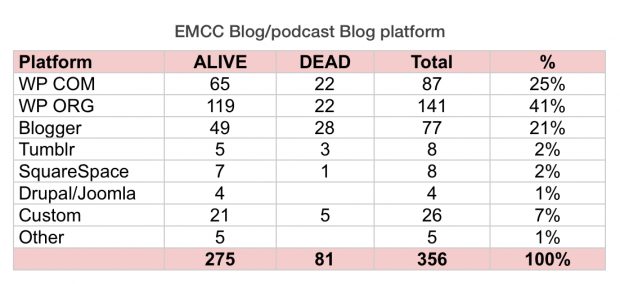FOAM EMCC Blogs 2016
Since 2009 we have reviewed, revised and revitalised the Emergency Medicine and Critical Care blogs (EMCC) database. It has been a great way to add new resources; marvel at the global collaboration and wealth of educational resources in the #FOAMed blogosphere and analyse the trends in the use of social media, and blogging platforms. In this 2016 analysis we review the #FOAMed conversation, blogging platforms and global spread of Free Open Access Medical Education and compare growth to 2011, 2012 and 2013 reviews.
Overview
Review of prospectively collected data pertaining to Emergency Medicine and Critical Care (EMCC) blogs and podcasts providing Free Open Access Medical Education (FOAM) with no barrier to entry (e.g. readers not required to logon to site or pay to read/listen).
- 356 EMCC blogs/podcasts were identified as either
- ALIVE (275) (currently functioning with at least 1 post within last 6 months);
- Note: a subgroup exists with profound bradycardia and hypotension… ‘GOING’ (45) (previously active with at least 10 posts but zero posts/podcasts for 6-12 months)
- DEAD (81) (previously active with at least 10 posts but zero posts/podcasts for greater than 12 months, or site redirected/incorporated)
Country of origin
- EMCC blogs are now written in 14 different languages (up from 6 in 2013)
- and originate from 33 different countries (up from 24 in 2013)
Attrition Rate
- 81 blogs/podcasts have been identified as ‘deceased‘
- 42 no longer exist, 23 point to alternate sites (mainly porn…), 12 still exist but last post greater than 24 months ago and 4 have been marked as private only. These blogs have been removed from the Active EMCC blog table
- The average ‘age‘ of the blog at the time of euthanasia was 52 months (4.3 years)
- The average ‘age‘ of the currently active blogs/podcasts is 62 months (5.2 years)
- The longest running blog (gruntdoc) is currently at 165 months (13.75 years)
Interesting factoids:
- Growth: EMCC blogs have grown from 67 in 2011, 130 in 2012, 201 in 2013 and 275 in 2016
- Disclaimer: A legal disclaimer now exists on 88% of sites
- Anonymity: There is better identification of authors with 96% of blogs and podcasts citing the full name, credentials, contact form and geographical location of blog authors
- Feed: Interestingly 16% (45/275) of blogs/podcasts fail to provide a valid RSS Feed for blog content. Without this valid feed it is impossible to syndicate and disseminate blog posts and data on FOAMEM.com
- Platform: WordPress.org has become the blogging platform of choice being used by 41% of EMCC bloggers.
Social Media Platforms
- Successful active blogs and podcasts show an increasing propensity to use social media to further discussion and information dissemination
- An overall increase in information dissemination through social media
- Twitter continues to be the mainstay of social media presence for blogs/podcasts rising from 72% in 2012 to 86% in 2016
- Facebook maintained a steady growth in popularity from 32% in 2012 to 39% in 2016
- Google+ showed a significant decline from 27% at its peak in 2013 to 16% in 2016
- iTunes/soundcloud maintained steady growth up to 28% in 2016
- Media accounts such as YouTube/Vimeo held steady, up slightly from 12% in 2012 to 15% in 2016
- The lower number of social media accounts associated with the deceased blogs/podcasts may have contributed to their attrition. Only 15/81 (18%) of the blogs pre-dated the 2012 FOAMed sharing concept.
Social Media Conversation #FOAMed
The FOAMed hashtag has become a useful means of disseminating media and medical education posts and advances in the twitter platform have made it easier to search, review, share and comment on posts/podcasts. We used Symplur to analyse the use of the hashtag, we compared the 6 months following inception in 2012 to the equivalent 6 months in 2015-2016.
- Tweet impressions increased from 40 Million to 725 Million
- Total tweets rose from 20,000 to 237,000
- Active participants surged from 2,400 to 30,000
- #FOAMed on twitter is the major source of referral and conversation in the online space. It’s use has grown significantly and the number of active users (with #FOAMed in their twitter profile) has increased from 500 in 2013 to 1,300 in 2016
Figure: #FOAMed Influencers 2012 compared to 2015

I am not sure exactly why there are so many EMCC blogs in existence, or why they are appearing with such rapidity. Maybe it is because a lot of our work is frontline, public, diverse and altruistic. There are myriad stories to be told and many educational resources being shared freely and without reservation using the language of FOAM.
Resources
- Cadogan M, Thoma B, Chan TM, Lin M. Free Open Access Meducation (FOAM): the rise of emergency medicine and critical care blogs and podcasts (2002-2013) [PMID 24554447]
- FOAM EMCC Blogs 2012
- FOAM EMCC Blogs 2014
- FOAM EMCC Blogs 2016
- FOAM EMCC Blogs 2018
- Kovic I. Twitterverse of Emergency Physicians [Infographic]
- Emergency Medicine and Critical Care (EMCC) resources








